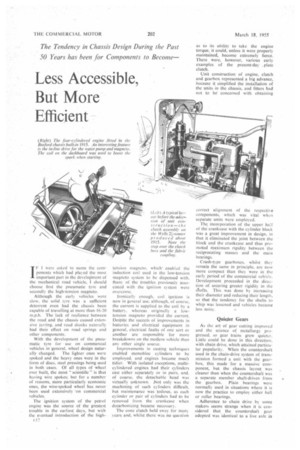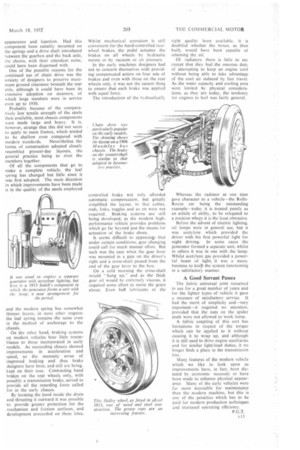Less Accessible, But More Efficient
Page 112

Page 113

If you've noticed an error in this article please click here to report it so we can fix it.
1 F I were asked to name the cornponents which had play ed the most important part in the develoPment of the mechanical road vehicle, I should choose first the pneumatic tyre and secondly the high-tension magneto.
Although the early vehicles were slow, the solid tyre was a sufficient deterrent even had the chassis been capable of travelling at more than 16-20 m.p.h. The lack of resilience between the road and the chassis caused extensive jarring, and road shocks naturally had their effect on road springs and other components.
With the development of the pneumatic tyre for use on commercial vehicles in general, wheel design natur ally changed. The lighter ones were spoked and the heavy ones were in the form of discs, steel pressings being used in both cases. Of all types of wheel ever built, the most " scientific" is that having wire spokes; but for a number of reasons, more particularly economic ones, the wire-spoked wheel has never been used extensively 'on commercial vehicles.
The ignition system of the petrol engine was the source of the greatest trouble in the earliest days, but with the eventual introduction of the high FE' tension magneto, which' enabled the induction coil used in the low-tension magneto system to be dispensed with, thany of the troubles previously associated with the ignition system were overcome.
Ironically enough, coil ignition is now in general use, although, of course. the current is supplied to the coil by a battery, whereas originally a
tension magneto magneto provided the current. DesPite the success of improvements in batteries and electrical equipment in general, electrical faults of one sort or another are responsible for more breakdowns on the modern vehicle than any other single source.
Improvements in casting techniques enabled monobloc cylinders to be employed, and engines became much tidier. With isolated exceptions, multicylindered engines had their cylinders cast either separately or in pairs, and. of course, the detachable head was virtually unknown. Not only was the machining of such cylinders difficult. hut maintenance was tedious, as each cylinder or pair of cylinders had to be removed from the crankcase when decarbonizing became necessary.
The cone clutch held sway for many years and, whilst there was no question as to its ability to take the engine torque, it could, unless it were properly maintained, become extremely fierce. There were, however, various early examples of the present-day .plate clutch.
Unit construction of engine, clutch and gearbox represented a big advance, because it simplified the installation of the units in the chassis, and fitters had not to be concerned with obtaining correct alignment of the respective components, which was vital when separate units were employed.
The incorporation of the upper ha:f of the crankcase with the c) linder block was a great improvement in design, in that it eliminated the joint between the block and the crankcase and thus promoted maximum rigidity between the reciprocating masses and the main bearings.
Crash-type gearboxes. whilst they remain the same in principle, arc now more compact than they were in the early period of the commercial veh;cle. Development proceeded in the direction of securing greater rigidity in the stafts. This was done by increasing their diameter and reducing their length, so that the tendency for the shafts to whip was lessened and vehicles became less noisy.
Quieter Gears
As the art of gear cutting improved and the science of metallurgy progressed, so gear trains grew quieter. Little could be done in this direction, with chain drive, which attained particular popularity. When the countershaft used in the chain-drive system of transmission formed a unit with the gearbox, this made for a massive component, but the chassis layout was cleaner than when the countershaft was a separate member shaft-driven from • the gearbox. Plain hearings were normally used in situations where it is now the practice to employ either ball or roller bearings.
Adherence to chain drive by some makers seems strange when it is considered that the countershaft gear adopted was identical to a live axle in
appearance and function. Had this component bccn suitably mounted on the springs and a drive shaft introduced between the gearbox and the back axle, the chains, with their attendant noise, could have been dispensed with.
One of the possible reasons for the continued use of chain drive was the anxiety of designers to preserve maximum ground clearance beneath the rear axle, although it could have been its extensive adoption on steamers, of which large numbers were in service even up to 1930.
Probably because of the comparatively low tensile strength of the steels then available, most chassis components were made large and heavy. It is, however, strange that this did not seem to apply to main frames, which tended to be shallow even compared with modern standards. Nevertheless the forms of construction adopted closely resembled present-day layouts, the general practice being to rivet the members together.
Of all the components that go to make a complete vehicle, the leaf spring has changed but little since it was first adopted. The main direction in which improvements have been made is in the quality of the steels employed and the modern spring has somewhat thinner leaves; in most other respects the leaf spring remains the same even in the method of anchorage to the chassis.
On the other hand, braking systems on modern vehicles bear little resemblance to those incorporated in early models. As succeeding chassis showed improvements in acceleration and speed, so the necessity arose of improved braking and thus brake designers have bccn, and still are being. kept on their toes. Contracting band brakes on the rear wheels only, with possibly a transmission brake, served to provide all the retarding force called for in the early chassis.
By locating thc hand inside the drum and thrusting it outward it was possible to provide greater protection for the mechanism and friction surfaces, and development proceeded on these lines. Whilst mechanical operation is still convenient for the hand-controlled rearwheel brakes, the pedal actuates thc brakes on all wheels by hydraulic means or by vacuum or air pressure.
In the early machines designers had not to concern themselves with providing compensated action on four sets of brakes and even with those on the rear wheels only. it was not the easiest thing to ensure that each brake was applied with equal force.
The introduction of the hydraulically controlled brake not only afforded automatic compensation, but greatly simplified the layout. in that cables. rods, links, toggles and so on were not required. Braking systems are still being developed, as the modern highperformance vehicle provides problems which go far beyond just the means for actuation of the brake shoes.
It seems difficult to appreciate that under certain conditions, gear changing could call for much manual effort. But such was the case when the gear lever was mounted in a gate on the driver's right and a cross-shaft passed from the end of the gear lever to the box.
On a cold morning the cross-shaft would 'hang up." and as the thick gear oil would be extremely viscous, it required some effort to move the gears about. Even hall lubricants of the right quality been available, it is doubtful whether the boxes, as then built, would have been capable of retaining the oil.
Of radiators there is little to say except that they had the onerous duty of attempting to keep an engine cool without being able to take advantage of the cool air induced by fast travel. As the water capacity and cooling area were limited by physical considerations, as they are today, the tendency for engines to boil was fairly general.
Whereas the radiator at one time gave character to a vehicle—the RollsRoyce car being the outstanding example—today it is treated purely as an article of utility, to he relegated to a position where it is the least obtrusive.
Before the advent of electric lighting. oil lamps were in general use, but it was acetylene which provided the driver with his first powerful light for night driving. In some cases the generator formed a separate unit, whilst in others it was in one with the lamp. Whilst acetylene gas provided a powerful beam of light, it was a messy business to keep the system functioning in a satisfactory manner.
A Good Servant Passes
The fabric universal joint remained in use for a great number of years and for the lighter types of vehicle it gave a measure of satisfactory service. It had the merit of simplicity and—very important—it required no attention, provided that the nuts on the spider studs were not allowed to work loose.
A fabric coupling of this sort has limitations in respect of the torque which can be applied to it without causing it to wrap up, and although it is still used to drive engine auxiliaries and for similar light-load duties, it no longer finds a place in the transmission line.
Many features of the modern vehicle which we like to look upon as improvements have, in fact, been dictated by economic necessity or have been made to enhance physical appearance. Many of the early vehicles were far more accessible for maintenance than the modern machine, but this is one of the penalties which has to be paid for modern production techniques and increased operating efficiency.
P.G.T. 1.13








































































































































































































































































